The Supermicro X12SCA-F is nothing short of intriguing. This motherboard utilizes the Intel Xeon W-1200 series, but can also support 10th gen Intel Core CPUs. We have a platform with Supermicro’s new-generation server IPMI, but also its gaming BIOS. There is a lot to unpack, so let us get to the review.
Supermicro X12SCA-F Overview
The Supermicro X12SCA-F is a single socket ATX motherboard that is a fascinating mix between a workstation and server platform. With the ATX form factor, we get access to a wide range of chassis from rackmount servers to full-sized desktops.

The socket itself is LGA1200 so we get support for the Xeon W-1200 series as well as the 10th generation Core line. Rocket Lake-S will be coming to the Xeon W segment in the Xeon W-1300 series, but we are not discussing this yet. We are still a few days before we can share details on the desktop Rocket Lake-S parts.
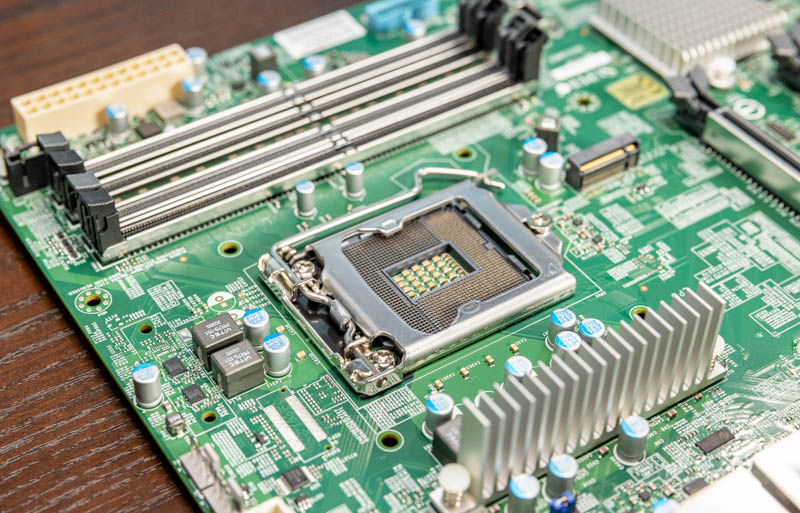
In this segment, we get a traditional 4x DDR4 DIMM layout which is dual-channel memory and capable of two DIMMs per channel. ECC is supported if the CPUs support it. Something you will notice from the photos is that these DIMM slots have metal reinforcement. This is more typical on the consumer side, but rarely if ever seen on the server-side. The DIMMs have latches on one side instead of both sides. This is a consumer motherboard feature we are not fond of. Still, it seems to be a feature that many people like, and others do not like so with either the traditional dual latch or the “gamer-focused” single latch design some will not agree with the design choice. That is what it is.
Below the CPU socket and before the first PCIe slot we get one of two M.2 slots in the system.
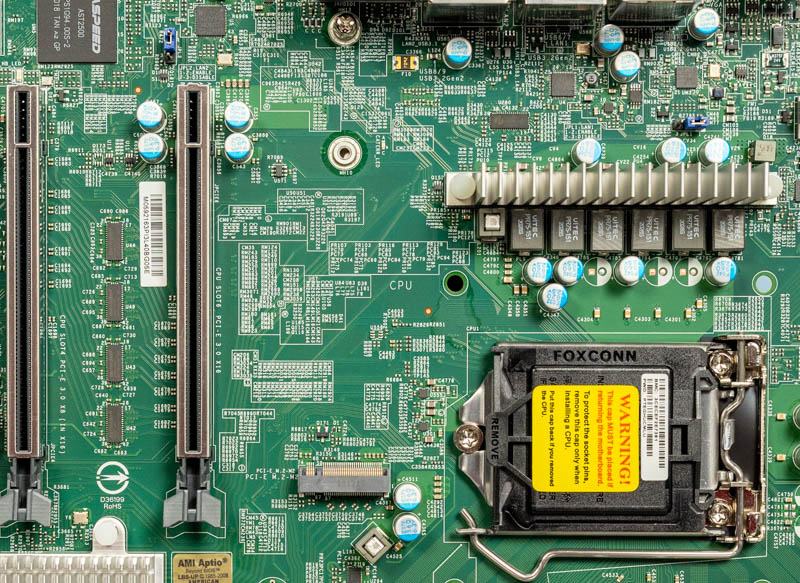
The PCIe configuration is interesting for a number of reasons. Many of our readers may recognize this motherboard from my Supermicro X12SAE Review. This is largely the same motherboard with the addition of the BMC. As a result of using PCIe for the BMC, we lose a PCIe x1 slot that is not populated on the X12SCA-F but is on the X12SAE. We still get the two PCIe 3.0 x16 physical slots that can be configured as x16/0 or x8/x8. These have metal reinforcements as well under a similar theory to the memory slots.
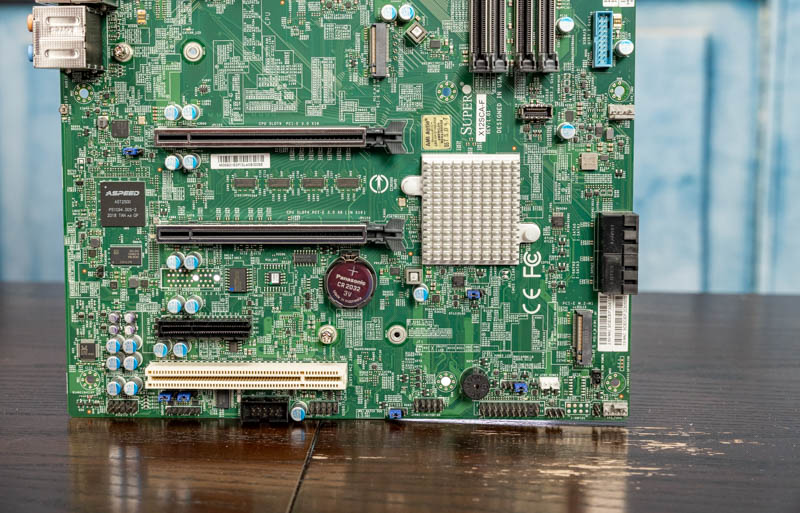
There is also a non-reinforced PCIe Gen3 x4 slot for extra I/O such as 10GbE networking. Finally, we still have a PCI slot from 20+ years ago as the long white slot on the bottom of this motherboard. For most buyers of this platform, that will be the computer equivalent to having a fossil on your motherboard, but apparently, the market for companies using old PCI card devices is still large enough that this is included. Other vendors such as Dell do the same thing, on less exciting designs, so Supermicro has this to ensure it is not a competitive differentiator.
In the bottom corner of the motherboard, we get the second M.2 slot. One can use two M.2 drives in this platform and, for example, mirror them for redundancy.

One feature that is a bit different is the SATA situation. Here, we only have four SATA 7-pin ports. For years, motherboards in this class offered 6+ SATA ports. These days, rotating storage is so much slower, and networking is getting faster, which makes it more practical to see rotating drives in NAS systems. We know many readers rely on the onboard SATA, but historically the vast majority of systems only used 1-2 SATA devices and with M.2 drives now offering decent capacity and much better performance, the need for more SATA is waning. The basic answer if you need more drives is to add a HBA/ RAID controller. While it may be a trend some readers will not like, this has been in motion for more than a decade.

The chipset on this system is not a Z590 or something similar as we would see on a gaming motherboard. Instead, it is the Intel W480 PCH designed for the workstation market. That PCH sits under the silver heatsink.
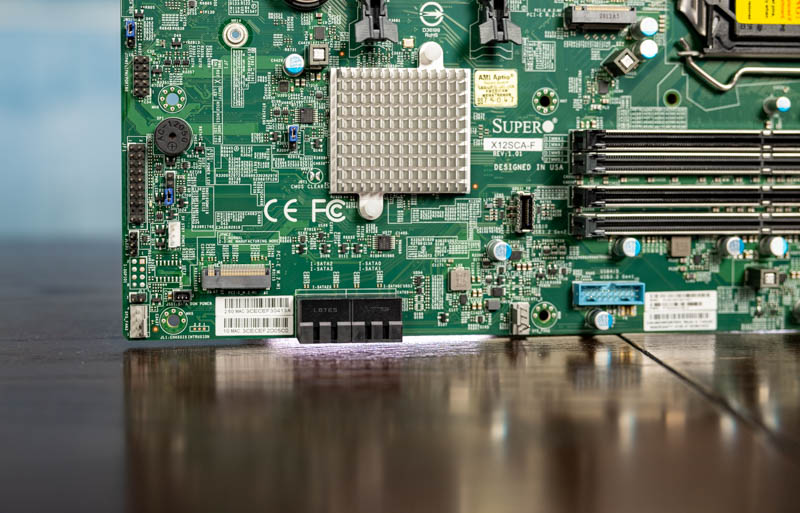
Looking at the front edge of the motherboard, we can see the motherboard’s name and the sides of the DIMM slots that are fixed. We mentioned that feature earlier, but this is another view. Near those fixed DIMM slot sides, we get USB 3.2 Gen2 and 3.2 Gen1 front panel headers. It is nice that we get support for higher-speed USB front panel connections.
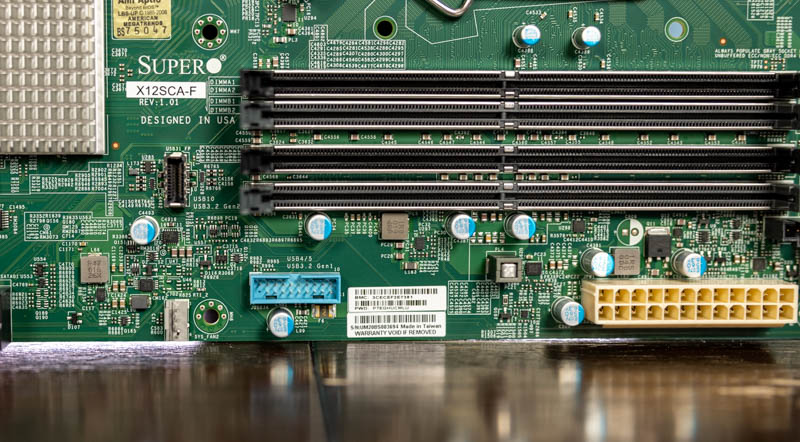
Next to the front panel USB connectors, we get the product labels. We have the serial, BMC, and the default ADMIN password. We will discuss more around the IPMI management solution, but this is an important label attached to the motherboard. There is also a standard ATX power input that is nicely placed at the edge of the motherboard and is easy to access.
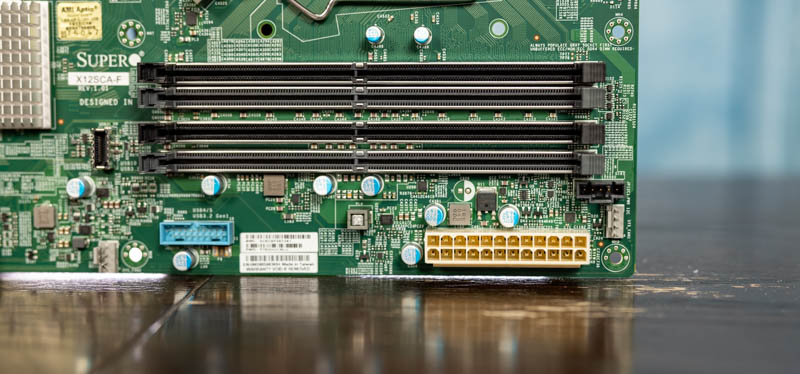
In terms of rear I/O, we get a DisplayPort port, a HDMI port, a DVI-D port, and a VGA port. The VGA port is on the X12SCA-F but not on the X12SAE since this is powered by the baseboard management controller. The BMC also powers the network port above the USB 3.2 Gen1 (blue) ports that was also not present on the X12SAE. The other ports are only active if the chip being used has an onboard GPU enabled. Many of the chips in this space do have onboard GPUs so these are the display outputs for those.
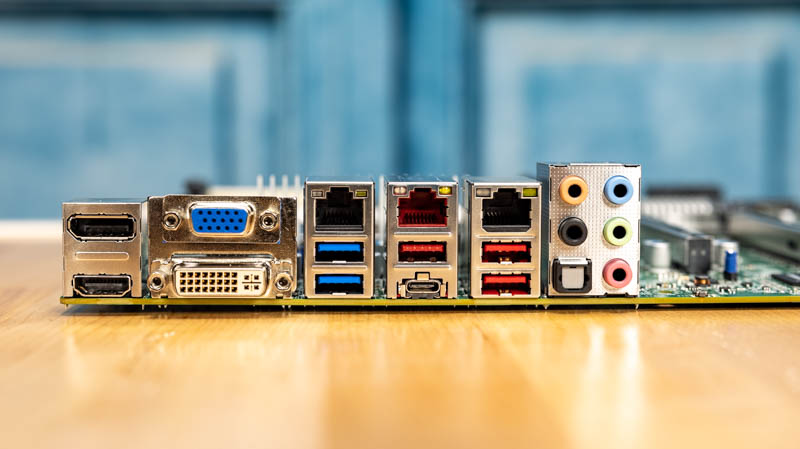
The remainder of the I/O is for USB, audio, and networking. We have two USB 3.2 Gen1 Type-A ports. There are also three USB 3.2 Gen2 Type-A ports along with a Gen2 Type-C port. USB naming is an absolute mess, so we are going to apologize here. This is very different from a typical server motherboard where we rarely if ever see USB 3.2 Gen2 ports. Supermicro is also using the ALC 888S audio codec. The company has five audio jacks as well as a S/PDIF optical output. This is a typical workstation solution.
The two network ports are interesting. We get a standard Intel i219LM PCH 1GbE NIC that has features such as AMT on it. We also have an Intel i225-V which is a 2.5GbE NIC. We are finally seeing the slow transition towards faster networking. This is the same as we saw on the X12SAE. We really like the inclusion of 2.5GbE here.

The big feature is the ASPEED AST2500. This clearly sets this motherboard apart from the X12SAE. This is an industry-standard Baseboard Management Controller or BMC found in servers. That means one can manage this platform like one would a server system.

We lost the PCIe x1 slot to re-route lanes to the BMC, but if you want a Xeon W platform with a BMC, this is a large differentiator for Supermicro.
Next, we are going to discuss the block diagram management, performance, and our final words.





It’s a home PC board tarted up with a management solution. It does not even give a nod to front to back airflow. IDK why Intel keeps up the S1151/S1200 Xeon fiction. I guess there are ppl who will pay a bit extra for those four letters.
They aren’t paying extra for the word ‘Xeon’, they are paying extra for the ECC support, which if you are a pro using a workstation that peace of mind can be worthwhile.
Board looks good but the IPMI feels a little redundant on a platform that can support AMT – would be nice if this had been tested on this and the equivalent board without IPMI – as I understand it you should be able to install meshcommander directly into the firmware to put a web interface on it:
https://www.meshcommander.com/meshcommander/firmware
Getting the HIGH END server gear to review –
Between You, Toms’s and The Corpse of Anandtech – you guys can’t get 1 high end product between you all.
Tim Walker
a Pro using a workstation does not have a use for 8C and 2 memory channels
I read somewhere that Intel is planning to expand the DMI link to x8 lanes.
Can anyone else shed some light on that rumor?
See Page 2 in this review, where DMI is still x4.
@Bob, I partially agree on the memory channels but I think 8C systems are still very important for many “Pros”. With software companies aggressively using per core licensing (i.e. Ansys) they are still relevant. This subject has been discussed on this website. This is especially true in a year where budgets may be tight and you may not be able to get those extra core license packs approved. You might be down to only 4 cores for simulation work. With the SKU’s being released by AMD and Intel I think they recognize this issue as well. Once W-1300 and Ice Lake release I’d love to see a round up of 8C system solutions.
@Bob they literally did these in a row like 2 weeks ago
https://www.servethehome.com/dell-emc-poweredge-xe7100-review/
https://www.servethehome.com/gigabyte-r292-4s1-server-review-2u-4-socket-cooper-lake/
https://www.servethehome.com/inside-an-innovium-teralynx-7-based-32x-400gbe-switch/
https://www.servethehome.com/amd-epyc-7003-milan-the-fast-gets-faster/
Maybe find somewhere else to troll? You have no credibility.
@Tim W, speaking as a guy who has been working in the computer racket as both a sysadmin and a dev for 25 years, the ECC claims qua workstations are overrated and almost entirely related to making customers feel good.
Anyone know if this board/BIOS will take an 11th Gen since they both are LGA 1200??